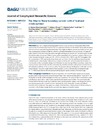Please use this identifier to cite or link to this item:
https://accedacris.ulpgc.es/handle/10553/72348
| DC Field | Value | Language |
|---|---|---|
| dc.contributor.author | Pérez Hernández, María Dolores | en_US |
| dc.contributor.author | Pickart, Robert S. | en_US |
| dc.contributor.author | Pavlov, Vladimir | en_US |
| dc.contributor.author | Våge, Kjetil | en_US |
| dc.contributor.author | Ingvaldsen, Randi | en_US |
| dc.contributor.author | Sundfjord, Arild | en_US |
| dc.contributor.author | Renner, Angelika H.H. | en_US |
| dc.contributor.author | Torres, Daniel J. | en_US |
| dc.contributor.author | Erofeeva, Svetlana Y. | en_US |
| dc.date.accessioned | 2020-05-13T12:37:44Z | - |
| dc.date.available | 2020-05-13T12:37:44Z | - |
| dc.date.issued | 2017 | en_US |
| dc.identifier.issn | 2169-9291 | en_US |
| dc.identifier.uri | https://accedacris.ulpgc.es/handle/10553/72348 | - |
| dc.description.abstract | Data from a shipboard hydrographic/velocity survey carried out in September 2013 of the region north of Svalbard in the Nansen Basin are analyzed to characterize the Atlantic Water (AW) boundary current as it flows eastward along the continental slope. Eight meridional transects across the current, spanning an alongstream distance of 180 km, allow for a detailed description of the current and the regional water masses. During the survey the winds were light and there was no pack-ice. The mean section reveals that the boundary current was O(40 km) wide, surface-intensified, with a maximum velocity of 20 cm/s. Its mean transport during the survey was 3.11 ± 0.33 Sv, of which 2.31 ± 0.29 Sv was AW. This suggests that the two branches of AW entering the Arctic Ocean via Fram Strait—the Yermak Plateau branch and the Svalbard branch—have largely combined into a single current by 30°E. At this location the boundary current meanders with a systematic change in its kinematic structure during offshore excursions. A potential vorticity analysis indicates that the flow is baroclinically unstable, consistent with previous observations of AW anticyclones offshore of the current as well as the presence of a near-field cyclone in this data set. Our survey indicates that only a small portion of the boundary current is diverted into the Kvitøya Trough (0.17 ± 0.08 Sv) and that the AW temperature/salinity signal is quickly eroded within the trough. | en_US |
| dc.language | eng | en_US |
| dc.relation.ispartof | Journal of geophysical research. Oceans | en_US |
| dc.source | Journal of Geophysical Research. Oceans [ISSN 2169-9291], v. 122, p. 2269–2290 | en_US |
| dc.subject | 2510 Oceanografía | en_US |
| dc.title | The Atlantic Water boundary current north of Svalbard in late summer | en_US |
| dc.type | info:eu-repo/semantics/article | en_US |
| dc.type | Article | en_US |
| dc.identifier.doi | 10.1002/2016JC012486 | en_US |
| dc.identifier.scopus | 2-s2.0-85017223336 | - |
| dc.contributor.orcid | #NODATA# | - |
| dc.contributor.orcid | #NODATA# | - |
| dc.contributor.orcid | #NODATA# | - |
| dc.contributor.orcid | #NODATA# | - |
| dc.contributor.orcid | #NODATA# | - |
| dc.contributor.orcid | #NODATA# | - |
| dc.contributor.orcid | #NODATA# | - |
| dc.contributor.orcid | #NODATA# | - |
| dc.contributor.orcid | #NODATA# | - |
| dc.description.lastpage | 2290 | en_US |
| dc.identifier.issue | 3 | - |
| dc.description.firstpage | 2269 | en_US |
| dc.relation.volume | 122 | en_US |
| dc.investigacion | Ciencias | en_US |
| dc.type2 | Artículo | en_US |
| dc.description.numberofpages | 21 | en_US |
| dc.utils.revision | Sí | en_US |
| dc.date.coverdate | Marzo 2017 | en_US |
| dc.identifier.ulpgc | Sí | es |
| dc.description.jcr | 2,711 | |
| dc.description.jcrq | Q1 | |
| item.grantfulltext | open | - |
| item.fulltext | Con texto completo | - |
| crisitem.author.dept | GIR IOCAG: Oceanografía Física | - |
| crisitem.author.dept | IU de Oceanografía y Cambio Global | - |
| crisitem.author.dept | Departamento de Física | - |
| crisitem.author.orcid | 0000-0001-7293-9584 | - |
| crisitem.author.parentorg | IU de Oceanografía y Cambio Global | - |
| crisitem.author.fullName | Pérez Hernández, María Dolores | - |
| Appears in Collections: | Artículos | |
SCOPUSTM
Citations
44
checked on May 18, 2025
WEB OF SCIENCETM
Citations
44
checked on May 11, 2025
Page view(s)
94
checked on Jan 18, 2025
Download(s)
58
checked on Jan 18, 2025
Google ScholarTM
Check
Altmetric
Share
Export metadata
Items in accedaCRIS are protected by copyright, with all rights reserved, unless otherwise indicated.
